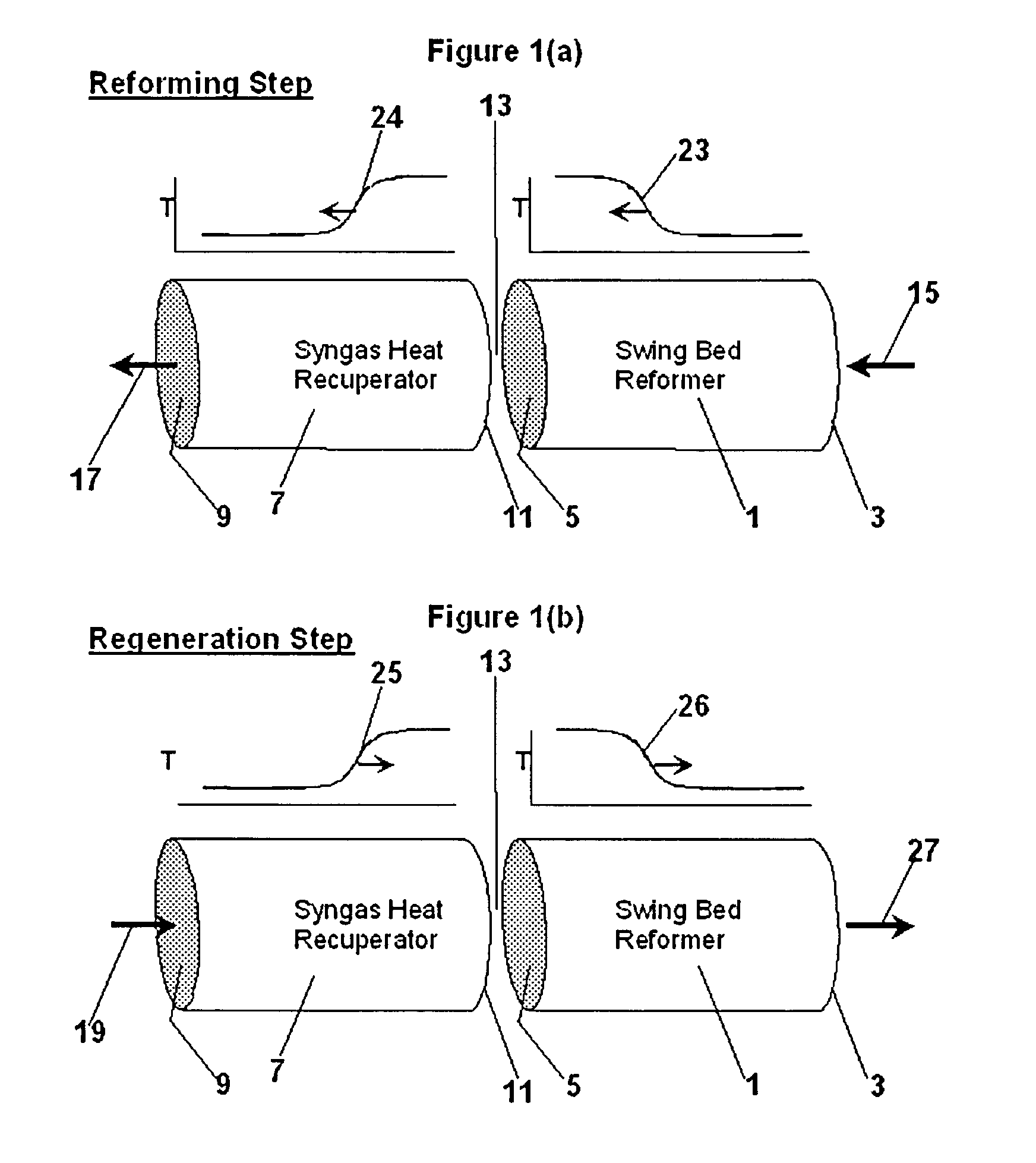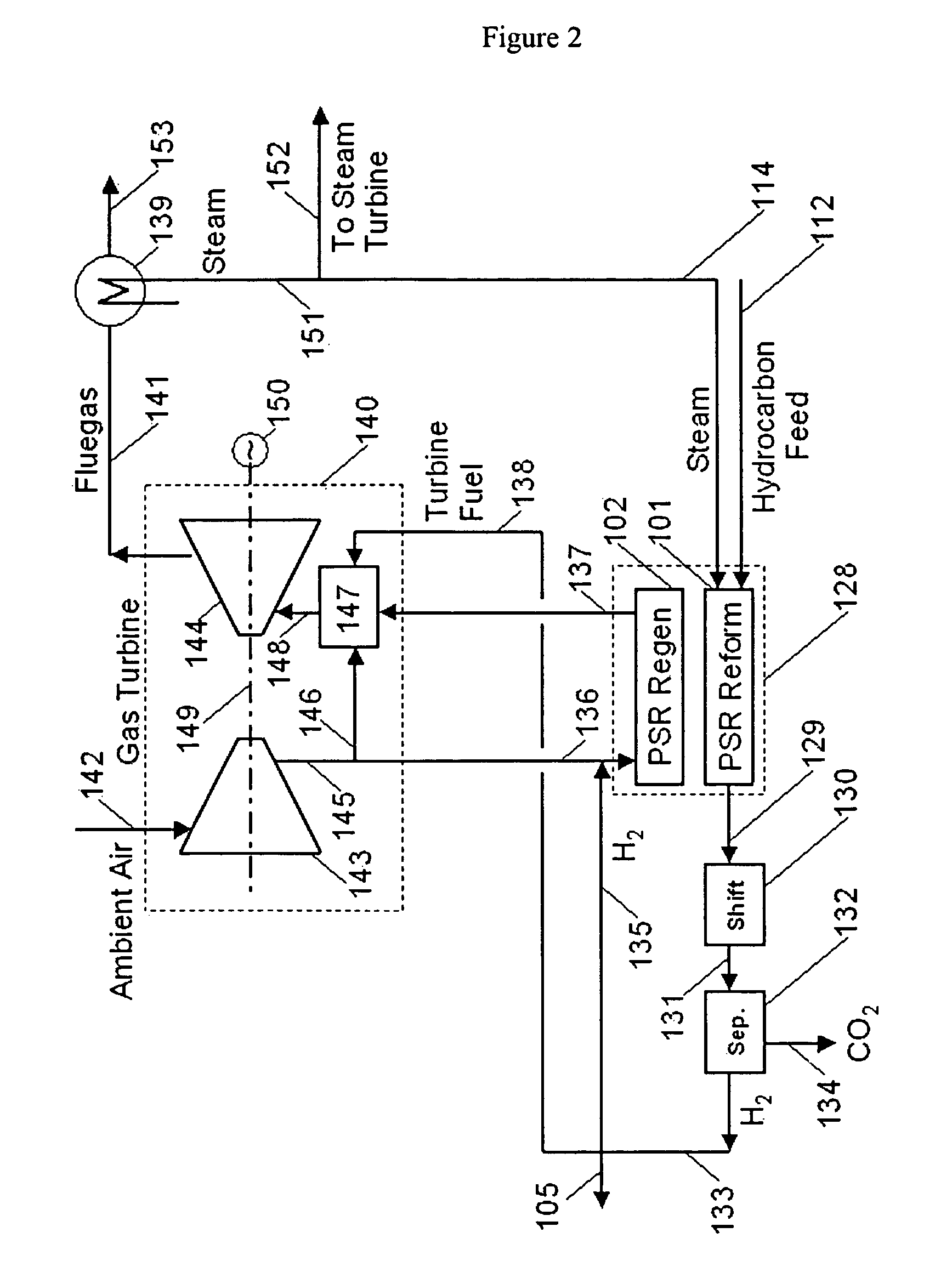Integration of hydrogen and power generation using pressure swing reforming
a technology of hydrogen and power generation, applied in the direction of hydrogen separation using solid contact, petrochemical industry, chemistry apparatus and processes, etc., can solve the problems of 20% or more fuel penalty, high cost and inefficiency of cosub>2 /sub>capture technology, etc., to reduce the volume flow rate and power requirement of the blower. , the effect of improving process efficiency
- Summary
- Abstract
- Description
- Claims
- Application Information
AI Technical Summary
Benefits of technology
Problems solved by technology
Method used
Image
Examples
example 1
[0055]To further illustrate the invention key streams of the calculated heat and material balance for the embodiment shown in FIG. 2 is given in Table 1. This pressure swing reformer system is operated as two cylindrical reactors, with internal dimensions of 11 ft (3.4M) diameter and 4 ft (1.2M) length. The reactors are positioned with cylindrical axis in a vertical orientation, and reforming is carried out as up-flow; regeneration as down-flow. The packing is composed of 400 cell / in2 (62 cell / cm2) honeycomb monolith having a bulk density of 50 lb / ft3 (0.8 g / cc). The bottom 70% of the packing includes reforming catalyst. Overall cycle length is 30 seconds; 15 s for the regeneration stage and 15 seconds for the reforming stage. A brief steam purge is included at the end of the reforming stage.
[0056]The reforming stage (101) is fed with methane (112) at the rate of 1760 kgmoles / hr, accompanied by steam (114) at a rate of 4494 kgmoles / hr, representing a reforming C1GHSV of 3,600 hr−1. ...
example 2
[0061]To further illustrate the invention, key streams of a calculated heat and material balance for the embodiment shown in FIG. 2 is given in Table 2. In this example, the pressure swing reformer operated at lower reforming efficiency by increasing the reforming space velocity and increasing regeneration flow rate relative to reform. Increasing space velocity at constant cycle time has the effect of increasing the amount of heat that is stored in the bed in each cycle. This results in a reform-bed temperature profile (26 of FIG. 1b) that must be closer to the bed outlet (3 of FIG. 1b) at the end of regeneration, and consequently a higher fluegas outlet (137) temperature. The increase in regeneration rate has the effect of driving the temperature profile (26 of FIG. 1b) even farther across the bed, resulting in yet higher regeneration fluegas (137) temperature. The reformer is less efficient because more of the heat value of the regeneration fuel (135) is expended to heat the flueg...
example 3
[0067]To further illustrate the invention, key streams of a calculated heat and material balance for the embodiment shown in FIG. 3 is given in Table 3. In this example, the pressure swing reformer operated as two cylindrical reactors, with internal dimensions of 11 ft (3.4M) diameter and 4 ft (1.2M) length. The reactor configuration, packing and cycle are the same as described with respect to Example 1.
[0068]The reforming stage (101) is fed with methane (112) at the rate of 1838 kgmoles / hr, accompanied by steam (114) at a rate of 4693 kgmoles / hr, representing a reforming C1GHSV of 3,600 hr−1. Syngas (129) is produced at rates shown in Table 3, is cooled to 280° C. by heat exchange to produce steam, and is converted in an adiabatic, high temperature shift reactor (130) to yield shifted product (131). Separation is accomplished using a high-temperature, palladium-based membrane system (170) operating at about 385° C. with internal water gas shift activity. Compositions, flows and con...
PUM
| Property | Measurement | Unit |
|---|---|---|
| pressure | aaaaa | aaaaa |
| pressure | aaaaa | aaaaa |
| pressures | aaaaa | aaaaa |
Abstract
Description
Claims
Application Information
 Login to View More
Login to View More - R&D
- Intellectual Property
- Life Sciences
- Materials
- Tech Scout
- Unparalleled Data Quality
- Higher Quality Content
- 60% Fewer Hallucinations
Browse by: Latest US Patents, China's latest patents, Technical Efficacy Thesaurus, Application Domain, Technology Topic, Popular Technical Reports.
© 2025 PatSnap. All rights reserved.Legal|Privacy policy|Modern Slavery Act Transparency Statement|Sitemap|About US| Contact US: help@patsnap.com



